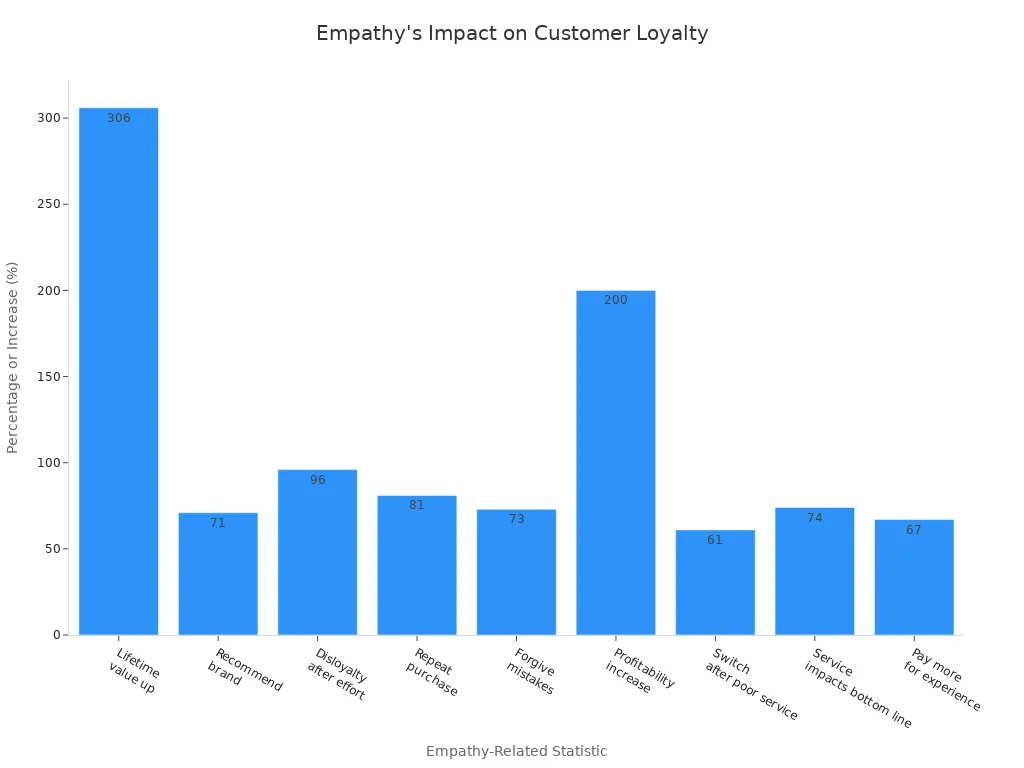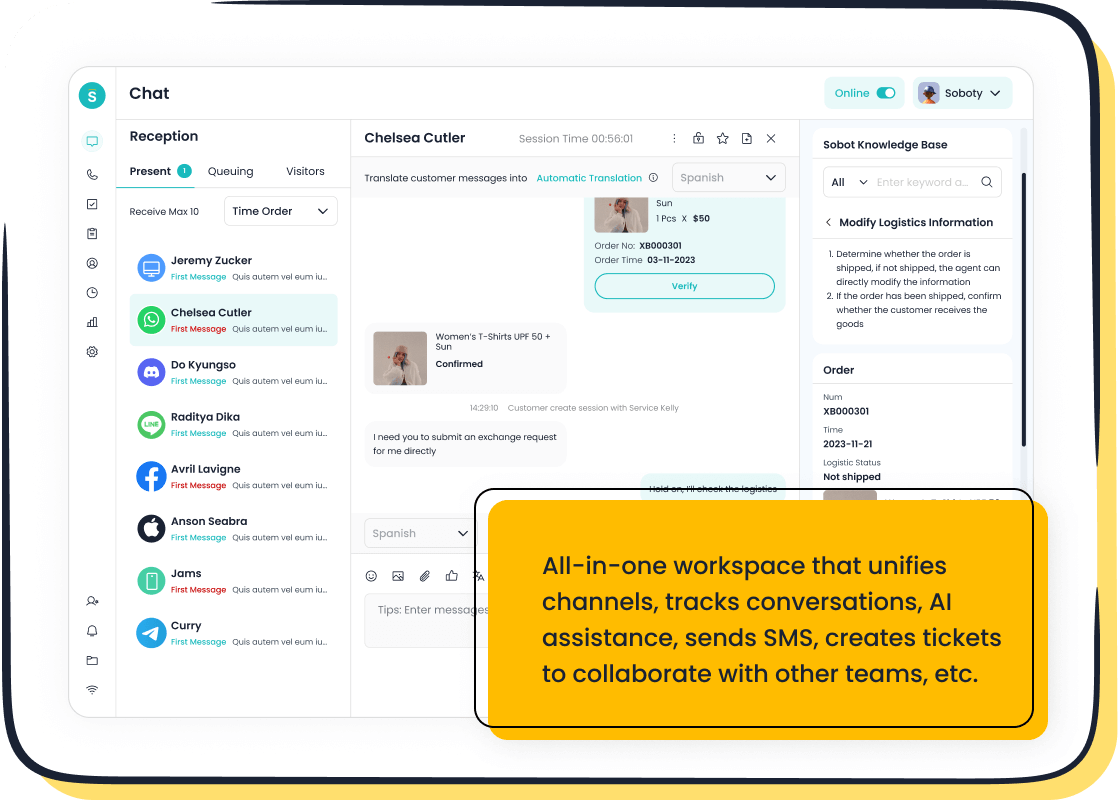Empathy statements for customers win hearts, apologies fix issues

Imagine you reach out to customer service because a charge appears on your account without warning. The agent says, “I can see how that charge would be frustrating, especially if you weren’t expecting it. Let’s take a look at what happened and fix this.” You feel heard. This is the power of empathy statements for customers. In customer service, empathy statements for customers build emotional connection, while apologies address specific issues. The right words can change a customer’s entire experience and create trust.
| Statistic | Impact/Insight |
|---|---|
| 306% higher lifetime value for emotionally connected customers (Motista) | Empathy fosters emotional connection, greatly increasing customer value |
| 71% of emotionally connected customers recommend brands to friends | Empathy drives referrals and loyalty |
| 96% of customers consider disloyalty after difficult, high-effort experiences | Lack of empathy leads to customer churn risk |
| 81% of customers more likely to repeat purchases after a good experience | Empathy improves repeat business |
| 73% of customers forgive mistakes if issues are resolved quickly | Empathy and quick resolution build forgiveness and retention |
A great customer service experience goes beyond solving problems. You want customers to feel valued and understood. Sobot and Sobot AI help agents deliver caring, effective communication across every channel, making each customer feel important. Reflect on your last call to a Sobot call center or any service—did you feel empathy, or just an apology?

Empathy Statements for Customers

Definition
Empathy statements for customers are words or phrases you use in customer service to show understanding and care for a customer’s feelings. When you use empathy statements, you let customers know you see their frustration, confusion, or disappointment. This helps you build a respectful and human connection. Empathy statements go beyond just saying “sorry.” They show that you understand what the customer is going through and that you are taking responsibility for their experience. In customer service empathy, you do not just feel sorry for the customer—you try to walk in their shoes and see things from their point of view. This approach makes customers feel heard, valued, and important.
Emotional Impact
Empathy statements have a strong effect on customers during support interactions. When you use empathy, you help customers feel understood before you offer solutions. This can calm angry or upset customers and set a positive tone for the conversation. Here are some ways empathy statements help:
- They validate the customer’s feelings and reduce negative emotions.
- They show you are present and engaged, making customers feel truly heard.
- They encourage customers to share more, which helps you find the real problem.
- They make customers feel valued and respected.
When you use the customer’s name or mirror their words, you build trust and rapport. This leads to higher customer satisfaction and loyalty. Companies often measure the impact of empathy with scores like NPS (Net Promoter Score) and CSAT (Customer Satisfaction Score).

Sobot Live Chat and Empathy
Sobot Live Chat helps you use empathy statements for customers across all channels. The platform uses AI-powered sentiment analysis to give you real-time insights into customer emotions. When a customer feels frustrated, Sobot alerts you so you can adjust your tone and use the right empathy statements. Sobot’s AI Copilot also helps you by suggesting personalized, empathetic responses. This makes your support faster and more caring. You can connect with customers on websites, apps, social media, and more—all from one place. Sobot Live Chat lets you focus on understanding and helping customers, which improves both satisfaction and efficiency.
Example empathy statements you can use in customer service:
- "I understand how frustrating that must be for you."
- "I can see how this situation has caused some inconvenience for you. Let’s work on resolving this as soon as possible."
- "I’m here to help and together, we’ll get this sorted out."
- "Thank you for your patience. Your satisfaction is my priority."
- "I completely understand your frustration, and I assure you, we’re on it."
Empathy statements for customers are a powerful tool in customer service empathy. They help you win trust, calm tense situations, and create loyal customers.
Apology Statements in Customer Service
Definition
An apology statement in customer service does more than say "I'm sorry." You use an apology to acknowledge a customer's issue, take responsibility, and show that you care about their experience. A good apology statement reassures the customer that you will fix the problem and prevent it from happening again. You build trust by showing empathy, explaining what went wrong, and promising to make things right. When you give a sincere apology, you help reduce conflict and improve customer satisfaction. You should personalize your apology, include ownership, and explain your plan to resolve the issue. This approach helps you repair relationships and demonstrate genuine care for every customer.
Role in Issue Resolution
Apology statements play a key role in resolving customer issues. When you offer a full apology, you show regret and care, which helps reduce anger and increase sympathy from the customer. You can see this in industry research: 45% of customers withdrew negative reviews after receiving an apology, while only 23% did so after getting compensation. A sincere apology can make customers more willing to forgive your company than money alone. You also improve your company's image and increase loyalty by taking responsibility and acting quickly. Apology statements help you:
- Reduce the desire for customers to punish your company.
- Improve emotional responses and encourage forgiveness.
- Lead to better outcomes in negotiations and settlements.
- Build trust and show your commitment to customer service.
You should avoid partial or insincere apologies, as these can make the situation worse. Always follow your apology with a clear solution and a promise to follow up. Sobot's unified workspace helps you track every customer interaction, so your apology can be specific and informed, not generic.
When to Use Apologies
You should use apology statements in customer service when customers feel frustrated, inconvenienced, or let down. Here are some situations where an apology is most effective:
1. Acknowledge mistakes as soon as you notice them to prevent escalation. 2. Express sincerity and take full responsibility without shifting blame. 3. Offer a brief explanation, but do not make excuses. 4. Provide a solution or compensation to show your commitment. 5. Communicate steps you will take to prevent future problems.
Tip: Avoid over-apologizing or using scripted responses. Customers want to feel heard, not brushed off.
You should use clear, respectful language and avoid jargon. Focus on fixing the problem and moving forward. For example, if a technical issue delays a customer's order, you can say, "I apologize for the delay. I understand how important this order is to you. I am working to resolve it now and will update you as soon as possible." Sobot Live Chat helps you respond quickly and track follow-ups, so your apology feels timely and genuine. Always follow up after resolving the issue to ensure the customer feels satisfied and valued.
Empathy Versus Apology
Key Differences
You may wonder about the real difference between empathy and apology in customer service. Empathy statements show that you understand and care about the customer’s feelings. You use empathy to connect with customers, even when you have not made a mistake. For example, you might say, “I can see how this situation is upsetting.” This shows understanding and compassion without admitting fault.
Apology statements, on the other hand, admit responsibility for a specific issue. You use an apology when your company or service has made a mistake. For example, you might say, “I’m sorry we sent the wrong item. Let me fix this for you.” Here, you take ownership and promise to resolve the problem.
“Empathy is appropriate 100% of the time, while apology is appropriate only after a review has proven a mistake. For example, saying 'I'm sorry you spilled coffee on your lap' expresses empathy by acknowledging feelings without admitting fault. However, saying 'I'm sorry I knocked your coffee over and it spilled on your lap; let me pay for your dry cleaning' is an apology because it admits fault and offers amends. Empathy focuses on connection and understanding, whereas apology involves admitting responsibility for a mistake.”
You should use empathy in every customer interaction. You use apology only when you know your service caused the problem. This difference between empathy and apology helps you avoid apology fatigue and keeps your communication positive. Empathy builds trust and connection. Apology repairs trust when your service falls short.
Effects on Customer Loyalty
Empathy and apology both shape how customers feel about your service. Research shows that empathy statements calm tense situations and validate customer emotions. When you use empathy, you help customers feel heard and valued. This leads to trust and a better overall experience.
A recent survey of 3,000 consumers in the US and UK found that 96% consider empathy from customer service agents important during support interactions. When you show empathy, customers feel understood, even if you cannot solve the problem right away. This emotional connection drives loyalty, positive reviews, and repeat sales.
Apology statements also matter. When you admit a mistake and take responsibility, you reduce frustration and show that you care about the customer’s experience. Apology, combined with empathy, creates a collaborative environment. Customers feel valued and are more likely to forgive mistakes.
Empirical research supports the long-term value of empathy. Empathy has a strong positive effect on consumer forgiveness, which increases the chance that customers will buy from you again. Forgiveness mediates about 39% of the total effect of empathy on repurchase intention. If your service has a good reputation, empathy has an even stronger effect on customer retention. This means that empathy not only helps in the moment but also builds lasting loyalty.
You can see the difference between empathy and apology in action. Empathy helps in every interaction, while apology is best when your service has made a mistake. Both play a role in keeping customers loyal, but empathy has a bigger impact on long-term retention.
Combining Both Approaches
You get the best results when you combine empathy and apology in your customer service. Industry leaders know that too many apologies can frustrate customers. Instead, they focus on understanding and quick action. You should use empathy to show you care, then use apology when your service is at fault.
Here are some best practices for combining empathy and apology:
- Greet customers by name to make them feel valued.
- Acknowledge their feelings and show understanding, such as, “I understand how this can be concerning.”
- If your service made a mistake, apologize clearly and take responsibility.
- Explain what you will do to resolve the issue, for example, “Here’s what I am going to do to help you.”
- Keep customers updated with progress or timelines.
- End the conversation with appreciation, like, “Thank you for choosing us. It was a pleasure serving you.”
Tip: Empathy should come first. Apology should follow only when you confirm a mistake. This approach avoids over-apologizing and keeps the focus on helping the customer.
You can use technology to help your team deliver empathy and apology statements. Sobot’s Live Chat platform uses AI to analyze customer emotions and suggest empathetic responses. This helps your agents respond with understanding and care, even during busy times. Sobot’s unified workspace keeps all customer data in one place, so you can personalize your service and track every interaction. This makes it easier to combine empathy and apology in a way that feels genuine.
A table can help you see how empathy and apology work together:
| Approach | When to Use | What It Does | Example Statement |
|---|---|---|---|
| Empathy | Every customer interaction | Shows understanding and builds connection | "I can see how this would be frustrating for you." |
| Apology | When your service made a mistake | Admits fault and promises to fix the issue | "I’m sorry for the delay. I will resolve this now." |
| Both Combined | When a mistake affects the customer | Builds trust, repairs relationships | "I understand your frustration, and I apologize for the inconvenience. Here’s what I’ll do to help." |
Industry leaders use empathy and apology together to achieve high customer satisfaction. They avoid long or repeated apologies, which can lower satisfaction. Instead, they focus on quick solutions and genuine understanding. AI tools like Sobot’s Live Chat help maintain this balance by providing context-aware, empathetic responses and tracking customer needs across channels.
You can improve your customer service by using empathy and apology in the right way. This approach helps you win hearts, fix issues, and keep customers coming back.
Crafting Effective Empathy Statements
Steps for Customer Service Teams
You can create strong empathy statements by following a few clear steps. These steps help you connect with every customer and make your support more effective. Here is a simple process you can use:
- Acknowledge the customer's feelings. Start by recognizing what the customer is experiencing. For example, say, "I can see that you’re really upset about this."
- Express understanding. Show that you relate to their emotions. You might say, "It sounds like you’re going through a tough time."
- Offer support. Let the customer know you want to help. Try, "Let’s work together to find a solution."
- Be genuine and sincere. Use real language and avoid sounding robotic. Customers notice when you care.
- Tailor your response. Adjust your words to fit the customer’s situation. Each customer is unique.
- Stay positive and respectful. Even if a customer is upset, keep your tone calm and helpful.
Here is a table with examples you can use in your support conversations:
| Empathy Statement Type | Example Phrases |
|---|---|
| Validating feelings | "Your concerns are completely valid." |
| Reassuring the customer | "We’re going to take care of this for you." |
| Showing gratitude | "Thank you for your patience as we work through this." |
| Confirming understanding | "Just to make sure I’ve got this right, you need us to…" |
| Offering support | "We’re here to help you every step of the way." |
Tip: Always close your message with a positive note, like "Let us know if you have any other questions."
Sobot Solutions in Practice
Sobot’s omnichannel solution helps you deliver empathy in every customer interaction. The platform uses AI to understand customer emotions and guide your support team to respond with care. Sobot combines automation with human-like understanding, so you can keep conversations smooth and consistent across all channels. The system uses advanced language models to suggest empathetic replies and helps you keep track of each customer’s needs. This means you can offer support that feels personal, no matter where the customer contacts you.
Sobot also makes it easy to switch between automated chatbots and human agents. The platform keeps the context of the conversation, so customers never have to repeat themselves. Sentiment analysis tools help you spot when a customer feels upset, so you can step in with the right empathy statements. This approach builds trust and loyalty, making your support stand out.
The story of Michael Kors shows how empathy can transform customer support. Michael Kors used Sobot to unify all customer channels and provide fast, caring service. By understanding customer needs and responding with empathy, the brand reduced response times by 83% and reached a 95% satisfaction rate. This success proves that empathy, supported by the right tools, leads to happier customers and better business results.
Best Practices for Customer Support
Training and Tools
You can build a strong customer service experience by investing in the right training and tools. Start with structured empathy training. Use role-playing, scenario-based exercises, and call analysis to help your team practice real-world situations. Team workshops let you share best practices and learn from each other.
Sobot’s omnichannel platform supports your team with features like call recording, live chat monitoring, and AI-powered sentiment analysis. These tools give you real-time feedback and help you improve your communication. You can also use personal development plans and regular coaching sessions to keep your skills sharp.
Here are some key training practices:
- Practice active listening and reflect customer concerns.
- Express gratitude for customer patience and input.
- Use positive language and avoid negative words.
- Personalize every communication to avoid sounding scripted.
- Manage stress with mindfulness exercises and regular breaks.
Tip: Recognize and reward team members who show strong empathy and communication skills. This boosts morale and encourages others to improve.
Measuring Success
You need to measure how well your team delivers empathy and apology in every customer interaction. Use direct customer feedback to learn if your service met their expectations. Ask for suggestions and close each conversation with a thank you.
Track key metrics to see how your team performs:
- Customer Satisfaction (CSAT)
- Net Promoter Score (NPS)
- Customer Effort Score (CES)
- First Contact Resolution (FCR)
- Sentiment analysis from chat and call transcripts
Sobot’s analytics dashboard helps you monitor these metrics in real time. You can spot trends, review chat transcripts, and use post-interaction surveys to gather insights. Research shows that empathy can raise CSAT scores by up to 35% (source).
Use these insights to adjust your training and improve your customer service experience.
Continuous Improvement
Continuous improvement is critical to staying connected with your customers. Encourage honest feedback so you can understand their feelings and find ways to improve. Set clear goals using KPIs like CSAT, FCR, and average resolution time.
You can:
- Create a coaching environment with regular feedback.
- Embrace an omnichannel strategy to meet customers on their favorite platforms.
- Use technology like Sobot to automate simple tasks, freeing agents to focus on empathy.
- Foster a culture of recognition and reward for great service.
- Hire people with strong empathy and problem-solving skills.
Stay committed to analyzing feedback and performance data. This helps you spot areas for growth and keeps your team focused on delivering a great customer service experience.
Remember, staying connected through open communication and continuous learning builds loyalty and trust.
Empathy statements help you win the customer’s heart and build loyalty by showing you understand and value each customer. Apologies fix issues, but empathy creates a real connection that leads to repeat customer purchases and positive feedback. You should combine both approaches for the best customer experience. Sobot Live Chat lets you recognize customer emotions, respond quickly, and handle many customer conversations at once. To improve, you can:
- Listen to customer feedback and analyze trends.
- Train your team to understand customer needs.
- Use technology to personalize every customer interaction.
Review your customer communication strategy today. Make every customer feel valued and understood.
FAQ
What are empathy statements for customers, and why do they matter?
Empathy statements for customers show you understand how someone feels. These statements help you build trust and make customers feel valued. Research shows that 81% of people return after a good experience. Sobot Live Chat helps you use empathy statements for customers across all channels.
How can Sobot help you deliver empathy statements for customers?
Sobot Live Chat uses AI to suggest empathy statements for customers in real time. You get alerts when a customer feels upset. This helps you respond with care and improve satisfaction. Sobot’s unified workspace keeps all conversations in one place for easy follow-up.
When should you use empathy statements for customers instead of apologies?
You should use empathy statements for customers in every interaction, even if there is no mistake. Apologies work best when your service causes a problem. Empathy statements for customers help you connect, while apologies fix issues. Combining both creates a better experience.
Can empathy statements for customers improve business results?
Yes! Empathy statements for customers increase loyalty and satisfaction. For example, Michael Kors used Sobot’s platform and saw a 95% customer satisfaction rate. Empathy statements for customers help you win hearts and keep customers coming back. Learn more about Sobot’s solutions here.
See Also
Effective Strategies To Improve Customer Satisfaction Through Live Chat
How AI-Powered Agents Are Transforming Customer Support Today
Comparing The Best Voice Of Customer Software Solutions
Authentic Customer Experiences Using Shopify Live Chat Features
